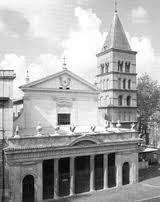La Basilica sotterranea di San Crisogono in Trastevere è una delle più antiche chiese di Roma.
La prima chiesa venne costruita nel IV secolo, sotto papa Silvestro I (314-335), ma venne ricostruita prima nel XII secolo e poi ancora nel 1626, su progetto di Giovanni Battista Soria, per volere del Cardinale Scipione Caffarelli-Borghese, i cui emblemi araldici (aquila e drago alato) si ripetono ovunque. Il campanile è quello dell'edificio del XII secolo.
Sotto l'attuale Chiesa sono visibili i resti della prima, scoperti nelle indagini archeologiche del 1907 e nei successivi scavi, dai quali venne alla luce la Schola cantorum, il presbiterio e la cripta semianulare con affreschi rappresentanti i Santi Crisogono, Anastasia e Rufino cinti di aureola, nel cui corridoio i pellegrini passavano per rendere omaggio ai resti di San Crisogono.
Sempre dell'VIII secolo sono anche gli affreschi commissionati da Papa Gregorio III conservati lungo la parete superiore dell’abside, con decorazione a dischi e losanghe, che richiamano le decorazioni a finto marmo; a destra e a sinistra, sono presenti un secretarium, con pavimento in tessere marmoree a motivo floreale, in cui è stato recuperato un sarcofago marmoreo con motivi marini del II secolo d.C.
Il vano battesimale, in origine era una fullonica, aveva accesso diretto da via di San Gallicano; al centro del vano è ancora conservata la vasca battesimale, divisa dalla struttura muraria in età medievale.
Sul lato sinistro della basilica vi è un altare a blocco affrescato con decorazioni a rotae concentriche dell’XI secolo e due sarcofagi marmorei, ritratti di santi entro nimbo in parete e materiale marmoreo appartenuto all’arredo liturgico della primitiva Chiesa.
Sul lato destro abbiamo sarcofagi in terracotta e affreschi, con storie di San Benedetto che guarisce il lebbroso, il Salvataggio di San Placido, San Pantaleone che guarisce un cieco, Papa Silvestro che cattura il drago. Sul fondo dello stesso ambiente, tramite una scala moderna, si accede all’antico vano di ingresso della basilica paleocristiana.
 Altare con affreschi a rotae
Altare con affreschi a rotae
The Underground Basilica of St. Crisogono in Trastevere is one of the oldest churches in Rome, the first church was built in the fourth century, under Pope Silvestro I (314-335), but was rebuilt first in the twelfth century and then again in 1626, ofdesign by Giovanni Battista Soria, at the behest of Cardinal Scipione Caffarelli-Borghese, whose heraldic emblem (eagle and winged dragon) are repeated everywhere. The bell tower is the building of the twelfth century.
Under the present Basilica there are the remains of the first church, discovered in archaeological excavations of 1907 and subsequent excavations, from which came to light, the Schola Cantorum, the semicircular chancel and the crypt with frescoes depicting the Saints Crisogono, Anastasia and Rufino, girded halo, in which the pilgrims passed through the hall to pay homage to the remains of St. Crisogono.
Always eighth century frescoes are also commissioned by Pope Gregorio III held along the upper wall of the apse, decorated with lozenges and discs, reminiscent of the decorations in imitation marble, left and right, there are a secretarium, with floor marble tiles in a floral motif, which was recovered a marble sarcophagus with marine motifs of the second century AD
The baptismal room, was originally a fullonica had direct access to Via di San Gallicano, the center of the room is still preserved the baptismal font, divided by the wall structure in the Middle Ages.
On the left side of the basilica there is an altar decorated with painted block concentric rotation of the eleventh century and two marble sarcophagi, portraits of saints in a halo on the wall and marble material belonged liturgical furnishings of the early Church.
On the right side we have terracotta sarcophagi and frescoes, with stories of St. Benedetto, who heals the leper, the Rescue of St. Placido St. Pantaleone, that heals a blind man, Pope Sylvestro to capture the dragon. At the bottom of the same environment, using a modern staircase, you enter the old entrance hall of the early Christian Basilica.
https://youtu.be/QR_np5pYgAM

